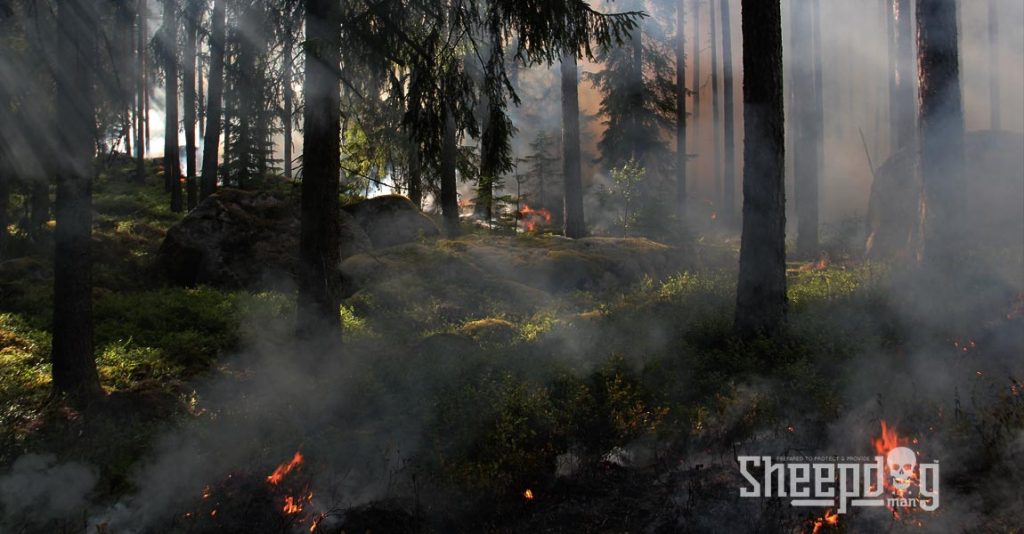The Big List of Nasty Disasters Part 15: How to Survive Fire
The ability to start a fire in any situation is an essential survival skill. But what do you do when a fire gets out of control? Or worse yet, what do you do when your vehicle, home, or office spontaneously and unexpectedly ignite?
Master The Fire Preparedness Essentials
Forest Fires & Wildfires
In 2015, 58,916 human-caused wildfires burned over 2 million acres.
Therefore, it is important to make sure that you are part of the solution by completely extinguishing your fire before leaving your campsite. The best way to extinguish your fire is with water, or with dirt.
If using water, make sure that you pour water on it until you no longer hear hissing.
Also, remember what Smokey say’s,
If it’s too hot to touch, it’s too hot to leave!
Furthermore, do not leave optical items like eyeglasses or bottles anywhere where they could magnify the sun’s rays and start a fire.
For more campfire safety tips download Smokey’s Campfire Safety Checklist.
How to Survive a Forest Fire or Wildfire
The greatest danger you face is the temptation to panic, lose your calm, run in the wrong direction, and end up inhaling smoke and carbon monoxide.
Therefore, remain calm and confident in your ability to escape, control your breathing, and follow these guidelines.
- Try to determine the direction of the wind by looking at the smoke and keep upwind of the fire.
- Do not try to outrun a forest fire if it is close. A forest fire can travel as fast as 5mph.
- Get to the nearest body of water and get into it. Keep yourself soaked and stay away from anything on the shore that can burn. Rocks might get hot, and the water might get warm, but it should not get hot enough to harm you unless it is a very large fire and a very shallow stream or pond.
- Improvise a mask from your clothing or use a water-soaked bandana. The fire may deprive the area of oxygen so remain calm and breath normally.
- Do not go into hollows or caves.
- If there are no bodies of water nearby head for the biggest non-flammable area, you can find. Sometimes this will be an area that has already burned. Naturally, enter such areas with caution, as they could still be hot. Make sure that the fire is completely extinguished in that area first.
- Avoid canyons, saddles, and natural chimneys.
- You may be able to use a paved road as a fire barrier.
How to Survive a House Fire
Unfortunately, according to researchers at Princeton University,
Thousands of Americans die in home and building fires each year, but most of these deaths could be avoided.
The greatest danger you face in a house fire is inhaling smoke and poisonous gas. The best way to prevent breathing in dangerous smoke and carbon monoxide is to get out of your home as quickly as possible — before it’s too late.
Consequently, the only way to ensure that you are aware of smoke or dangerous gas before it’s too late is to have an adequate number of smoke detectors installed in your home.
I highly recommend detectors that also alert to Carbon Monoxide, such as the Kidde Battery-Operated Combination Smoke/Carbon Monoxide Alarm.
Many people die from Carbon Monoxide poisoning before they become aware that there is a fire in their home.
Also, make sure that you check the batteries in your smoke detectors frequently, and follow these additional tips.
- Practice fire drills with your family every three months so that your children know not to hide and plan a meeting place outside.
- Make sure that everyone in the family knows how to call 911, and print your address somewhere where it can be easily found – such as on the back of phones. You might be surprised how difficult it can be to remember your address under the stress of an emergency.
- Determine exists and teach everyone where they are. Each room should have at least two exists.
- Install hook-on ladders or rope ladders for upper floor windows.
- Assign an adult or older person for each young child who will make sure that the child can evacuate.
- Always touch a door before you open it. If it’s too hot to exit through the door, put wet towels, blankets, or clothes at the base of the door, this prevents the draft caused by opening the window from drawing smoke into the room. Escape out the window.
- Improvise a mask with wet clothing or a towel or cloth.
- Stay close to the ground.
- Remain calm and breathe normally.
- When an alarm is sounded yell, “FIRE EVERYONE OUT!”
- Sleep with doors closed. Doors block smoke and toxic fumes as well as heat. If you must go from room to room make sure you close the doors behind you.
- Remember, if your clothes catch on fire, “STOP, DROP, AND ROLL.”
How to Survive and Prepare for a Vehicle Fire
According to the National Fire Protection Association,
Each year in the United States more than 300 people on average die in a vehicle fire. 1
A couple of years ago I was heading to the mountains for a hunting trip when my transmission started to slip and then grind while driving down the freeway. Since I was only 40 miles out, I decided to try and drive the vehicle back home.
Halfway back, smoke started to enter the cabin. I jumped out and very carefully opened the hood. My engine was on fire. Thankfully, I had a fire extinguisher and was able to put the fire out within seconds. In this instance, the fire caused no damage to either the vehicle or to its operator. However, if I had not had the fire extinguisher with me that day, it would have been a very different story.
Unfortunately, things did not go so well for another family I know. When their car started on fire — after an accident — with no knife to cut the seatbelt and with no fire extinguisher on board the parents were unable to save their son.
There were a couple of invaluable lessons learned that day.
An additional benefit is that you can use the extinguisher as an escape tool, to break a window, or even as an improvised weapon.
2) MAKE SURE THAT EVERYONE OLD ENOUGH TO BE RESPONSIBLE HAS ACCESS TO A TOOL THAT CAN CUT A SEATBELT!
If you don’t carry a knife already, an excellent instrument for this is the StatGear SuperVizor XT Auto Escape Tool – Seatbelt Cutter and Window Breaker. This tool is the only seatbelt cutter and window breaker that attaches to your sun visors. Now that’s handy.
Putting Out an Engine Fire
The best way to extinguish an engine fire is to have two people, one to crack the hood (lift only high enough to spray the motor with your fire extinguisher) and another to fire the extinguisher.
It’s important to get the fire out as soon as possible otherwise the fire may destroy the release cable and make it impossible to lift the hood.
Stay Away from the Cone of Danger
When the fire reaches the gas tank, which is usually in the back, it can cause an explosion and cone shaped blast behind the vehicle that can be lethal as far as 100ft away.
Armed with this knowledge you are now better prepared to survive a fire in the forest, at home or in your vehicle.
Have you experienced any of these three types of fires? I would like to hear about it. Leave a comment.
As always, thank you for your time, friends! And please consider becoming part of the Sheepdog Man community by joining our Facebook Group or even better by signing up for our Newsletter.
Press on!

